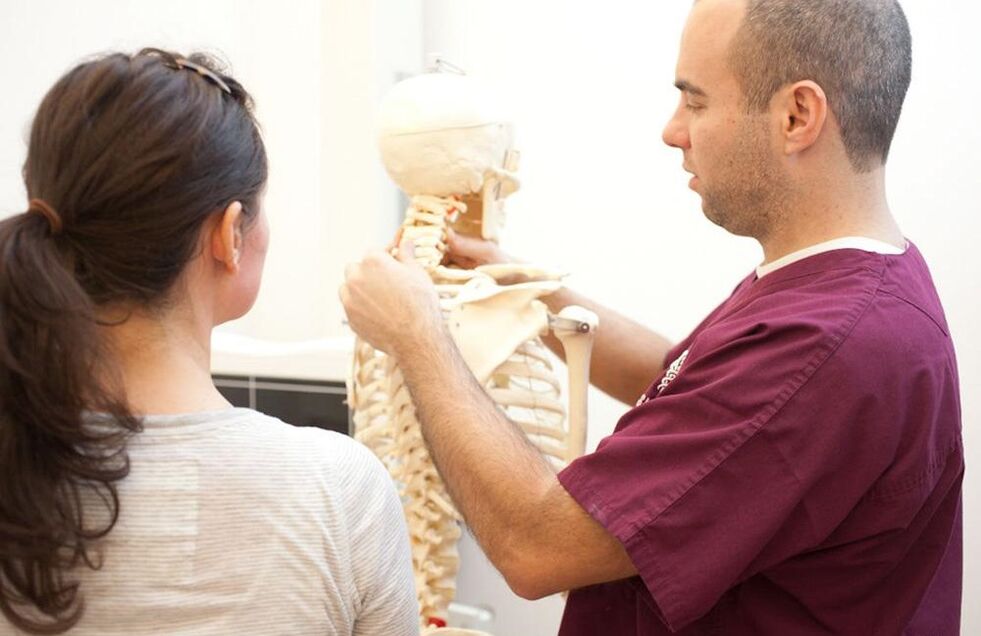
In the article, we will consider the symptoms and treatment of osteochondrosis of the cervical spine. What is this pathology? How does it manifest?
Osteochondrosis is a disease that is practically the most common in the world. Many people after the age of 30 suffer from this pathology in various forms. There is also a tendency to rejuvenate the disease, that is, to lower the age threshold. This may be due to the fact that there are now more and more people who are mainly engaged in work, where a person spends most of the time sitting and leads a sedentary lifestyle. By the way, this disease is dangerous, and everyone should know what cervical osteochondrosis is, how it appears, how to treat it, and how to identify its symptoms.

The main causes of the appearance of the disease
A person is designed in such a way that the vertical positioning of the spine can lead to the vertebrae becoming tighter and tighter over time, allowing bone and cartilage tissue to gradually degrade and deform.
The spine always begins with the cervical region, which has seven vertebrae. This is a particularly vulnerable part, because there is greater mobility in this area. Such a disease of the cervical spine is reflected, first of all, in the discs themselves, because they are a weak point in the spine.
The frequency of degenerative disc disease of the cervicothoracic region is favored by factors such as the small size of the vertebrae and the relative weakness of the neck muscles. Also, poor blood supply to cartilage tissue affects the developing ailment. What does this all mean?
Judging by this, the development of this disease appears to be a long and complex process, where it is very difficult to recognize the cause. Although a connection between a sedentary lifestyle and osteochondrosis of the cervicothoracic spine has been found, however, a similar ailment is often found in trained people, especially athletes, due to the fact that they have a higher load on the cervical spine. . They lift various weights (bars, dumbbells), which leads to deformation of the discs. So everything needs a measure.

In the elderly and the elderly, as a rule, such degradation of the vertebral structures is an inevitable process, which in turn is associated with the aging of the body and the weakness of its defenses. But there may also be a pathological type of osteochondrosis of the cervical spine, the symptoms of which appear due to internal or external negative factors. These include:
- various back injuries;
- rachiocampsis;
- Heavyweight
- wrong posture;
- hypodynamics;
- hard physical work;
- altered metabolic processes;
- hypothermia;
- overwork, stress;
- infectious diseases;
- inheritance;
- congenital pathologies or special characteristics of the body structure.
Stages of osteochondrosis of the cervical spine.
The pathology has four stages. Sometimes it is quite difficult to determine in what stage of the disease a patient is present, based on the general analysis, since most of the time the level of degradation of the bone tissue may not coincide with the symptoms seen in the patient.
The first stage of the disease.
At this stage, destructive actions are already taking place on the vertebrae. But the symptoms of cervical osteochondrosis are not yet very pronounced. People may not notice them or not associate these signs with a disease of the spine, they call it stress or banal overwork.
The second stage of the disease.
As already noted, the symptoms and treatment of cervical osteochondrosis are closely related.
At this stage, there is a noticeable thinning of the disc and cracks appear on its surface. Symptoms of cervical osteochondrosis at this stage are observed in constant pain, facial numbness, weakness.

Third stage
How are the symptoms of osteochondrosis of the cervical spine manifested at this stage? Herniated discs occur, cervical vessels and muscles are affected. The person notices dizziness and pain in the back of the head.
The fourth stage of the disease.
With osteochondrosis of the cervical spine, osteophytes often occur - the proliferation of bone tissue that protects the vertebrae from stress, as a result of which leads to pinching of the nerves. This is characterized by stiffness of movement and damage to the adjacent joints.
Signs of cervical osteochondrosis
The main symptoms of osteochondrosis of the cervical spine are:
- Sharp pain in shoulders and neck.
- Weakening of the muscles.
- Increased sweating
- Impaired coordination.
- Numbness in the hands.
- Dizziness.
- Hypertension.
- Decreased hearing and vision.
- Headache.
These frequent symptoms of osteochondrosis of the cervical spine can manifest themselves at all stages of the disease. In most cases, only a few signs from this list are visible, while the rest may be completely absent. The patient who met them for the first time practically does not diagnose cervical osteochondrosis. In this case, you can turn to different doctors: cardiologists, neuropathologists, therapists, surgeons. And a reliable diagnosis in the end can be identified with a significant delay.
Pathology Hazard
Not everyone knows the symptoms and treatment of cervical osteochondrosis.
The most initial symptoms of osteochondrosis can appear from the age of 20, while the pain and discomfort are mild, so many people decide to wait, hoping that the symptoms will pass, postpone the visit to the doctor and not start treatment. Symptoms at an early stage of osteochondrosis can really go away on their own, but this disease will not go away from a person. If prevention and therapy are not carried out, osteochondrosis begins to develop further, and this can be dangerous for human health.

What are the dangers of osteochondrosis of the cervical spine?
In the first stage, the symptoms are mild, so most people prefer not to take this disease seriously. But if the patient does not start treatment early in development, this can lead to serious and dangerous complications. The consequences of a neglected stage are a condition in which a person cannot perform the functions of her. This can often be accompanied by injuries to adjacent departments. Such an abandoned osteochondrosis will have very dangerous consequences, followed by disability.
In addition, you can develop:
- bulging of the intervertebral discs;
- intervertebral bulges and hernias;
- loss of discs;
- lumbago or sciatica;
- spinous of the spinal canal.
In special cases, the diseases listed above are forced to undergo surgical intervention, and the consequence of an advanced stage is disability.
The problems listed above are characteristic of osteochondrosis of the cervicothoracic spine.
Complications of the disease.
The danger of the disease lies in the fact that the cervical region is connected to the vessels that supply blood to the brain. The consequences of the disease of cervical osteochondrosis are sleep disturbances, migraines, vision problems, dizziness. With advanced disease, the listed symptoms will become more noticeable. With cervical osteochondrosis, there is a possibility of concomitant problems:

- high or low blood pressure and vascular dystonia;
- thyroid disease;
- vestibular disorders;
- hypertension or hypotension;
- career;
- epicondylitis;
- humeroscapular periarthrosis.
Diagnosis of the pathology of the cervical spine.
The symptoms and treatment of osteochondrosis of the cervical spine are of interest to many.
For a correct diagnosis, you should consult a therapist. Provide referral to other specialists: neurologist, vertebrologist, orthopedist.
To diagnose the disease the following types of studies are attached:
- Computed tomography;
- bone scan;
- Magnetic resonance;
- Doppler scan.
Radiography reveals the presence of growths, displacement of the vertebrae, deposits of salt and osteophytes, disk seals. With the help of computed tomography, you can get a fairly voluminous idea of the organs, in this case, the cervical spine. It will allow to detail the stage of the pathological process, as well as the nature of the nerve impingement, the height of the discs and the structure of the osteophytes. The MRI provides an even more detailed image of the structure of the spine. An ultrasound can help determine how the blood flow in the great vessels of the neck has changed, which was caused by the disease.

Treatment of this ailment.
The symptoms and treatment of osteochondrosis of the cervical spine are interrelated.
In order for a person to resist the disease, medicine develops many methods. There are also therapies that you can use at home. But this procedure is long, and full recovery is unlikely, especially in old age. But it is also worth noting that it is possible to stop and slow down pathological processes in the spine at any stage of the disease.
In the early stages of the disease, the methods of treating osteochondrosis of the cervical spine are mostly conservative. Several methods can be used for therapy:
- physiotherapy;
- medicines;
- massage;
- physiotherapy;
- special devices for fixation of the spine.
If such a disease has passed to an extreme stage, while the osteochondral structure of the spine is being destroyed, a surgical intervention should be used to cure osteochondrosis of the neck.
Drugs for pathology therapy.
Necessary drugs for the treatment of osteochondrosis of the cervical spine:
- analgesics;
- vitamins
- chondroprotectors;
- anti-inflammatory drugs;
- antispasmodics.
When an acute pain syndrome occurs, which is associated with osteochondrosis, the most important task is to eliminate it. In such cases, oral painkillers are taken, but if the effect of them is not noticeable, novocaine blockade can be used.
The symptoms and treatment of osteochondrosis of the cervical spine often remain controversial for many.
Antispasmodics are often taken. Muscle relaxants show the greatest efficacy in osteochondrosis. As pain relievers and anti-inflammatory drugs, the patient can use ointments containing non-steroidal drugs.
If there are signs associated with a poor blood supply to the brain and vertebral artery syndrome, it is necessary to use drugs that eliminate its unpleasant manifestations - drugs that lower blood pressure and nootropic drugs.
The symptoms and treatment of osteochondrosis of the cervical spine are no longer a secret.

Physiotherapy exercises
Physiotherapy is the simplest and most accessible type of therapy and prevention of cervical osteochondrosis, and it is also quite effective. Physical therapy can also be done at home. With cervical osteochondrosis, the saturation of classes does not play an important role, only their regularity is needed. First of all, physical education is designed to strengthen the muscles of the neck, the task of which is to compensate for the lack of functionality of the spine and help support weakened vertebrae. Treatment of osteochondrosis of the cervical spine should be regular.
Daily exercise is necessary to strengthen muscles. These exercises can be very simple, such as turning and tilting the head in different directions, and quite complex, involving the hands to help the cervical muscles. They can be done both at home and at work. For example, if you have to work all the time while sitting, then it is very useful to perform several exercises every hour from sitting at a table and a monitor. But it is necessary to do this only when there is no exacerbation of the disease and there is no pain syndrome. Otherwise, these same exercises can only make the condition worse.
It is also effective in the treatment of osteochondrosis of the cervical spine to strengthen the muscles of the shoulder girdle, for example, use light dumbbells in regular exercises. However, lifting weights such as kettlebells or dumbbells is contraindicated. Regular swimming activities can be helpful as it relieves stress on the spine.
We examine the symptoms and treatment of osteochondrosis of the cervical spine.














































